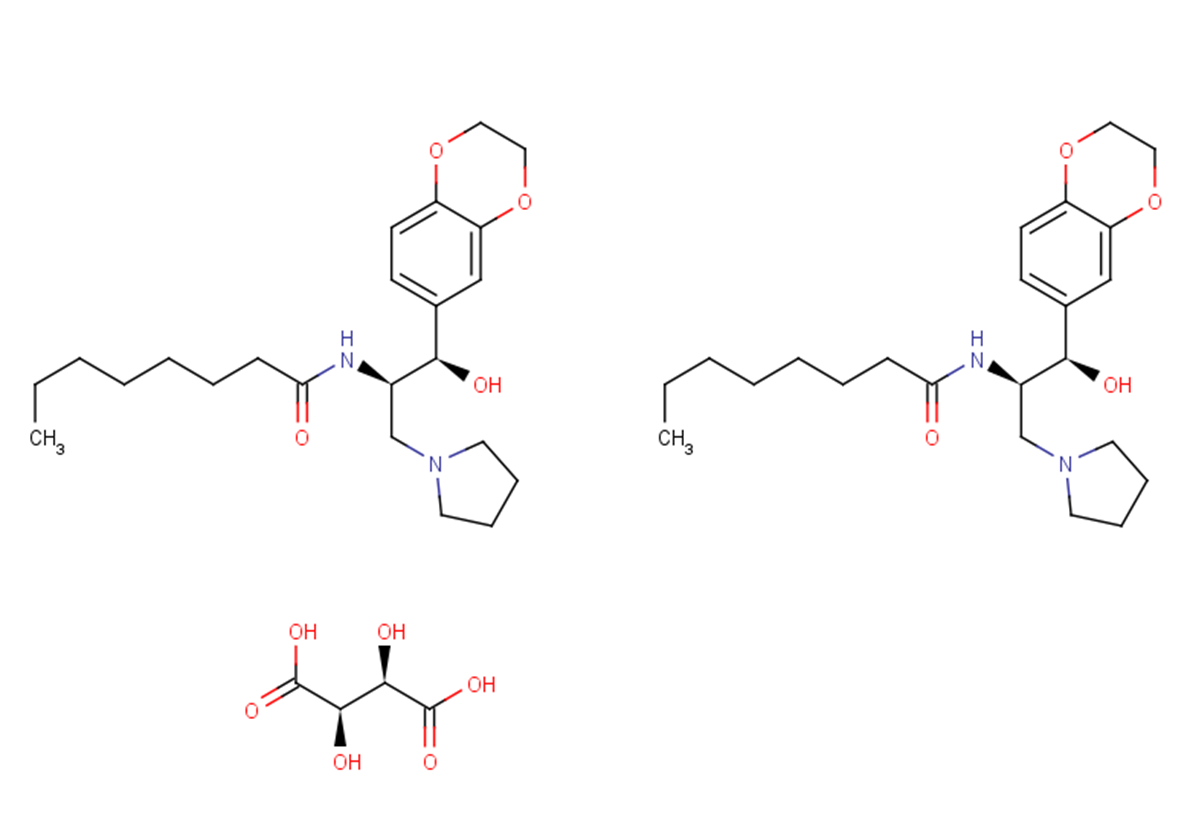
Eliglustat hemitartrate
CAS No. 928659-70-5
Eliglustat hemitartrate( Genz-112638,Eliglustat tartrate )
Catalog No. M22931 CAS No. 928659-70-5
Eliglustat Hemitartrate, with an IC50 of 24 nM, is a specific, potent, oral active glucocerebral glycosidase inhibitor.Eliglustat tartrate shows good potency with an IC50 of 24 nM and specificity against the target enzyme.A novel inhibitor of glucosylceramide synthase (Genz-112638) and assessed its activity in a murine model of Gaucher disease (D409V/null).?Biochemical characterization of Genz-112638 showed good potency (IC(50) approximately 24nM) and specificity against the target enzyme.?
Purity : >98% (HPLC)
 COA
COA
 Datasheet
Datasheet
 HNMR
HNMR
 HPLC
HPLC
 MSDS
MSDS
 Handing Instructions
Handing Instructions
| Size | Price / USD | Stock | Quantity |
| 5MG | 86 | In Stock |


|
| 10MG | 116 | In Stock |


|
| 25MG | 176 | In Stock |


|
| 50MG | 233 | In Stock |


|
| 100MG | 431 | In Stock |


|
| 200MG | Get Quote | In Stock |


|
| 500MG | Get Quote | In Stock |


|
| 1G | Get Quote | In Stock |


|
Biological Information
-
Product NameEliglustat hemitartrate
-
NoteResearch use only, not for human use.
-
Brief DescriptionEliglustat Hemitartrate, with an IC50 of 24 nM, is a specific, potent, oral active glucocerebral glycosidase inhibitor.Eliglustat tartrate shows good potency with an IC50 of 24 nM and specificity against the target enzyme.A novel inhibitor of glucosylceramide synthase (Genz-112638) and assessed its activity in a murine model of Gaucher disease (D409V/null).?Biochemical characterization of Genz-112638 showed good potency (IC(50) approximately 24nM) and specificity against the target enzyme.?
-
DescriptionEliglustat Hemitartrate, with an IC50 of 24 nM, is a specific, potent, oral active glucocerebral glycosidase inhibitor.Eliglustat tartrate shows good potency with an IC50 of 24 nM and specificity against the target enzyme.A novel inhibitor of glucosylceramide synthase (Genz-112638) and assessed its activity in a murine model of Gaucher disease (D409V/null).?Biochemical characterization of Genz-112638 showed good potency (IC(50) approximately 24nM) and specificity against the target enzyme.?Mice that received drug prior to significant accumulation of substrate (10 weeks of age) showed reduced levels of glucosylceramide and number of Gaucher cells in the spleen, lung and liver when compared to age-matched control animals.?Treatment of older mice that already displayed significant amounts of tissue glucosylceramide (7 months old) resulted in arrest of further accumulation of the substrate and appearance of additional Gaucher cells in affected organs.?These data indicate that substrate inhibition therapy with Genz-112638 represents a viable alternate approach to enzyme therapy to treat the visceral pathology in Gaucher disease.
-
In VitroEliglustat tartrate shows good potency with an IC50 of 24 nM and specificity against the target enzyme.Incubating K562 or B16/F10 cells for 72 h with increasing amounts of Genz-112638 (0.6-1000 nM) results in a dose-dependent reduction of cell surface levels of both GM1 and GM3. The mean IC50 value for inhibiting the cell surface presentation of GM1 in K562 cells was 24 nM (range 14-34 nM) and that for GM3 in B16/F10 cells was 29 nM (range 12-48 nM).
-
In VivoMice that received drug prior to significant accumulation of substrate (10 weeks of age) showed reduced levels of glucosylceramide and number of Gaucher cells in the spleen, lung and liver when compared to age-matched control animals.
-
SynonymsGenz-112638,Eliglustat tartrate
-
PathwayOthers
-
TargetOther Targets
-
Recptorglucocerebroside synthase
-
Research AreaMetabolism
-
IndicationGaucher′s Disease
Chemical Information
-
CAS Number928659-70-5
-
Formula Weight959.17
-
Molecular FormulaC50H78N4O14
-
Purity>98% (HPLC)
-
SolubilityH2O:50 mg/mL (52.13 mM);DMSO:50 mg/mL (52.13 mM)
-
SMILESCCCCCCCC(N[C@H](CN1CCCC1)[C@@H](C2=CC=C(OCCO3)C3=C2)O)=O.CCCCCCCC(N[C@H](CN4CCCC4)[C@@H](C5=CC=C(OCCO6)C6=C5)O)=O.O=C(O)[C@H](O)[C@@H](O)C(O)=O
-
Chemical Name——
Shipping & Storage Information
-
Storage(-20℃)
-
ShippingWith Ice Pack
-
Stability≥ 2 years
Reference
1. McEachern KA, et al. A specific and potent inhibitor of glucosylceramide synthase for substrate inhibition therapy ofGaucher disease. Mol Genet Metab. 2007 Jul;91(3):259-67.
molnova catalog



related products
-
Uracil
Uracil is one of the four nucleobases in the nucleic acid of RNA can be used for drug delivery and as a pharmaceutical.
-
3-(Dodecylamino)prop...
3-(Dodecylamino)propane-1,2-diol (3-(Dodecylamino)propane-1,2-diol) is a surfactant that can be used to prepare nanomicelles.
-
Kaempferol 3-O-arabi...
Kaempferol-3-O-α±-D-arabinoside displays cytotoxic and high antioxidant activity.



 Cart
Cart
 sales@molnova.com
sales@molnova.com


